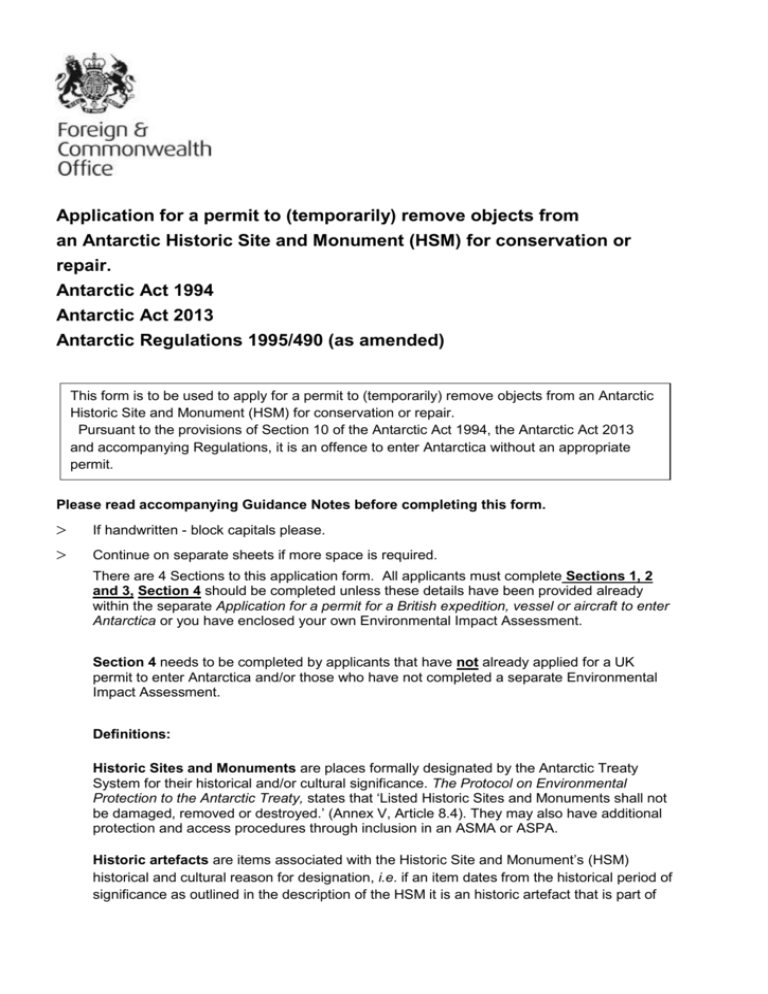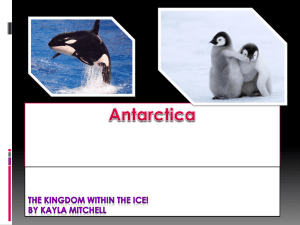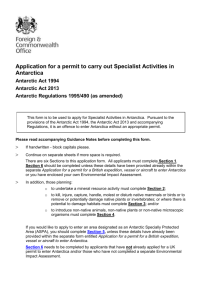Section 10 application form
advertisement

Application for a permit to (temporarily) remove objects from an Antarctic Historic Site and Monument (HSM) for conservation or repair. Antarctic Act 1994 Antarctic Act 2013 Antarctic Regulations 1995/490 (as amended) This form is to be used to apply for a permit to (temporarily) remove objects from an Antarctic Historic Site and Monument (HSM) for conservation or repair. Pursuant to the provisions of Section 10 of the Antarctic Act 1994, the Antarctic Act 2013 and accompanying Regulations, it is an offence to enter Antarctica without an appropriate permit. Please read accompanying Guidance Notes before completing this form. If handwritten - block capitals please. Continue on separate sheets if more space is required. There are 4 Sections to this application form. All applicants must complete Sections 1, 2 and 3, Section 4 should be completed unless these details have been provided already within the separate Application for a permit for a British expedition, vessel or aircraft to enter Antarctica or you have enclosed your own Environmental Impact Assessment. Section 4 needs to be completed by applicants that have not already applied for a UK permit to enter Antarctica and/or those who have not completed a separate Environmental Impact Assessment. Definitions: Historic Sites and Monuments are places formally designated by the Antarctic Treaty System for their historical and/or cultural significance. The Protocol on Environmental Protection to the Antarctic Treaty, states that ‘Listed Historic Sites and Monuments shall not be damaged, removed or destroyed.’ (Annex V, Article 8.4). They may also have additional protection and access procedures through inclusion in an ASMA or ASPA. Historic artefacts are items associated with the Historic Site and Monument’s (HSM) historical and cultural reason for designation, i.e. if an item dates from the historical period of significance as outlined in the description of the HSM it is an historic artefact that is part of the HSM. Examples include: buildings, an aircraft, scientific equipment, monuments, plaques, clothing, food, straw, paper documents, etc. Relocation on a temporary basis, may be applicable when conservation or repair is required to stabilise the physical condition of historic artefacts. Whilst conservation and repair in situ is preferred, temporary relocation to specialist conservation laboratories has the merit of accessing advanced technical facilities, a broad range of expert advice and, depending on the scale of work, reducing impacts on the Antarctic environment. Pre-1958 artefacts are items predating 1958 that are discovered during research and are automatically protected (Guidelines for handling of Pre-1958 historic remains whose existence or present location is not known. ATCM XXIV: Resolution 5, 2001.) until the nation of origin has evaluated the artefact/s for historical and cultural significance. In the event of such items being located the Polar Regions Department of the FCO should be notified. 2 Section 1 – Application details 1.1 Applicant details Full Name as per passport Full Postal Address International Telephone No. E-mail Organisation (if applicable) Nationality Passport Number A scanned copy of the photograph page of the passport of the applicant (who will become the permit holder if the application is successful) must be submitted with this application. 1.2 Arrival and departure dates Place of final departure for Antarctica Date of initial entry into Antarctica (60 South latitude) Date of final exit from Antarctica (60 South latitude) First place of call after final exit from Antarctica Period for which the permit is required From: To: 1.3 In addition to requesting a permit to temporarily relocate historic artefacts from an Antarctic Historic Site and Monument (HSM) for conservation or repair, have you applied or do you plan to apply for a UK permit to enter Antarctica? If yes, please provide the applicant’s details if different from those provided in Question 1.1. If no, please confirm under what authorisation you intend to enter Antarctica. (e.g. via authorisation granted by another Antarctic Treaty Party or through a permit obtained by the British Antarctic Survey (BAS) or another British institute) 1.4 Where will the proposed activity take place? 1.5 Does the expedition intend to visit any Antarctic Specially Protected Areas E.g. Rothera Point, Antarctic Peninsula (ASPA), Antarctic Specially Managed Areas (ASMA), wildlife sites or other protected areas? If yes, please provide details. 1.6 Other people who will be involved in the removal of any objects from within Historic Sites and Monuments (HSM) for conservation or repair, and therefore should be covered by this permit*. A full and final list (including their nationalities and passport numbers) must be submitted before departure; we are aware they may not be known at the time of application. Full name (as per their passport) e.g. John Alan Smith Nationality British Passport no. 123456789 Qualifications, training and previous experience of heritage conservation work in the Arctic, Antarctica or in other cold or high altitude areas? (Y/N) If ‘yes’ for previous column, please provide details Y *Where these names change prior to entry to Antarctica, please ensure that you inform the Polar Regions Department at the FCO and provide full details. 4 1.8 Has an Environmental Impact Assessment been undertaken? If ‘Yes’, please include a copy of the Assessment with your application and summarise the conclusions here. If ‘No’, you will need to complete Section 6. Section 2 –Removal of objects from within Antarctic Historic Site and Monuments (HSM) for the purpose of conservation or repair 2.1 Please outline why it is necessary to temporarily relocate these objects from Antarctica. 2.2 Is it possible to undertake this work without the removal of these objects? If yes please explain why removing is preferential. 2.3 From which authority or institution have you receive instruction to apply for the removal of these objects from Antarctica. E.g. UKAHT 2.4 Could any of the historic objects being considered for removal, contain materials or organisms which are considered harmful to humans or animals. (e.g. lead, asbestos, radioactive matter) 2.5 Could any of the objects within the historic site and monument contain materials or organisms which are considered harmful to the environment. 2.6 Could any of the objects within the historic site or monument contain materials which are at present considered controlled or prohibited substances under UK law. http://www.legislation.gov.uk/ E.g. illegal drugs, endangered / protected species etc 6 2.7 Could the Historic Sites or Monuments, or the objects within them which it is proposed to remove, be considered a part of another nation’s Antarctic history and heritage? If so, please confirm whether permission has been granted from the nation’s agency responsible for their Antarctic affairs to temporarily relocate and conserve or repair these artefacts on their behalf. 2.7 Do any of the objects from within the Historic Site or Monument, form part of any personal belongings to a person or persons who have visited Antarctica and, if so, is it clearly understood that regardless of ownership these objects will be returned to the Historic Site and Monument? 2.8 If yes, have you informed that person, or the relatives of that person or persons of the removal of the relevant historic artefacts from Antarctica? 2.9 Please include details of all objects within the Historic Site or Monument which you wish to remove, in the table below. Item description and protective status (i.e. HSM, pre 1958 or other) Item reference / tracking number (i.e. “modes” tracking reference) Dimensions / size of object Composite material (s) of object (e.g. wood, metal) Amount of items of this description being removed 8 Section 3 - Storage and transportation. 3.1 For each of the objects listed above in question 2.6 please complete information pertaining to storage and transportation methods in the grid below. Please be as descriptive as possible. Item description Item reference / tracking number (i.e. “modes” tracking reference) How will the item be packaged for transportation Will the removal of this item involve climate controlled storage? If yes please describe (e.g. specific temperature, humidity etc) Amount of items 3.2 Please list any airports / ports which the objects will pass through and subsequently be subject to custom control searches: 3.3 Are (any of) the historic objects usually prohibited from entry into or transit through any country you shall be required to transport them through? E.g. the Convention on International Trade in Endangered Species of Wild Fauna and Flora (CITES) includes provisions related to seal products. If yes please confirm whether you have received the required special permissions from these countries to allow their transit. 10 Section 4 – Environmental Impact: Preliminary Environmental Assessment. You should complete this section unless these details have already been provided within the separate Application for a permit for a British expedition, vessel or aircraft to enter Antarctica or you have enclosed your own Environmental Impact Assessment. 6.1 If you intend to visit site designated as Antarctic Specially Managed Areas (ASMA), Historic Site and Monuments (HSMs) or visitor sites with Site Guidelines for Visitors, please state how you will ensure that all members of the expedition will abide by the Management Plans and guidance that apply to those locations. (See: http://www.ats.aq/documents/recatt/Att004_e.pdf ) 6.3 Will any of the activities involve visits to sites which you believe may have not been visited before? If so, where? If the visit results in the discovery of the remains of human activity that predate 1958, are your group aware of their obligations under ATCM XXIV: Resolution 5, 2001, and the requirement to notify the Foreign Office? 6.4 Will any hazardous substances be taken into Antarctica? Please list any hazardous substances (e.g. chemical substances), radioactive material or stable isotopes that you propose to use. For each substance, please list (i) the hazard class, (ii) the quantity, (iii) why it is required and (iv) whether or not they will be released into the environment. Please explain how they are intended to be used. 6.5. Do you intend to install any equipment in Antarctica (e.g. data loggers or markers)? If yes, please provide (i) a brief description of the equipment, (ii) a summary of the installation location, (iii) detail of how the equipment will be maintained and (iv) when it will be removed. 6.6. Do you intend to store fuel, outside the main tanks of a vessel or within the Antarctic terrestrial environment? For each fuel type please state the quantity and location of the storage facility. If a fuel transfer is to be undertaken, please state the quantity and location of the storage facility. If a fuel transfer is to be undertaken, please provide details including a copy of the fuel Spill Contingency Plan. 6.7. Please provide details of waste disposal procedures proposed for the expedition: Sewage Quantity expected to be generated Packaging and Disposal practices Grey water Quantity expected to be generated Packaging and Disposal practices 12 Food waste (other than meat and poultry product waste) Quantity expected to be generated Packaging and Disposal practices Meat and poultry product waste Quantity expected to be generated Packaging and Disposal practices General waste Quantity expected to be generated Packaging and Disposal practices 6.8 Where will wastes removed from Antarctica be disposed of? 6.9. Please describe how the Permit holder will ensure compliance with current Antarctic environmental legislation (including the Protocol on Environmental Protection to the Antarctic Treaty) 6.10. How will the Permit holder ensure the expedition members covered by this Permit will be fully informed of all their environmental responsibilities? (Including, but not limited to disturbance of wildlife, introduction of non-native species, waste disposal, respecting historic sites and minimising trampling impacts). 6.11 Environmental Impact Matrix Please complete the matrix located on the following page for each activity you intend to undertake. List all activities involved. This should include any science activities as well as logistical activities such as the storage and handling of fuels and chemicals, waste management and camping activities. Consider the likely impact of your actions on flora and or fauna and the marine and terrestrial environment. You should also consider cumulative impacts on the environmental, historic, aesthetic, wilderness and scientific value of the site. Effects on the value of the area for future visitors should also be considered. Provide details of the mitigation which will be undertaken to ensure that negative impacts are minimised or avoided. Please note that you can either extend the amount of rows within the matrix or submit your own version of an environmental impact matrix, if the space provided is inadequate for the entirety of your activities. 14 Environmental Impact Matrix Activity Duration and intensity of activity Possible impact Mitigating measures Checklist – please ensure you have included with your application: A copy of the photograph page of the applicant’s passport Where appropriate, a copy of your own Environmental Impact Assessment (Q1.8) Signature In accordance with Regulation 2 of The Antarctic (Amendment) Regulations 2008/3066, brief details of all permit applications will be published on the FCO website. Your signature below will be taken as consent to publish the necessary information. Please provide below the details for publication. Signature of applicant Date Official position (if applicable) Summary of purpose of application to appear on the FCO website e.g. The temporary relocation of three sets of clothing dating from the 1950s from HSM x to the Scott Polar Research Institute for conservation. This application form should be returned to: Polar Regions Department Overseas Territories Directorate Foreign and Commonwealth Office King Charles Street London SW1A 2AH polarregions@fco.gov.uk







